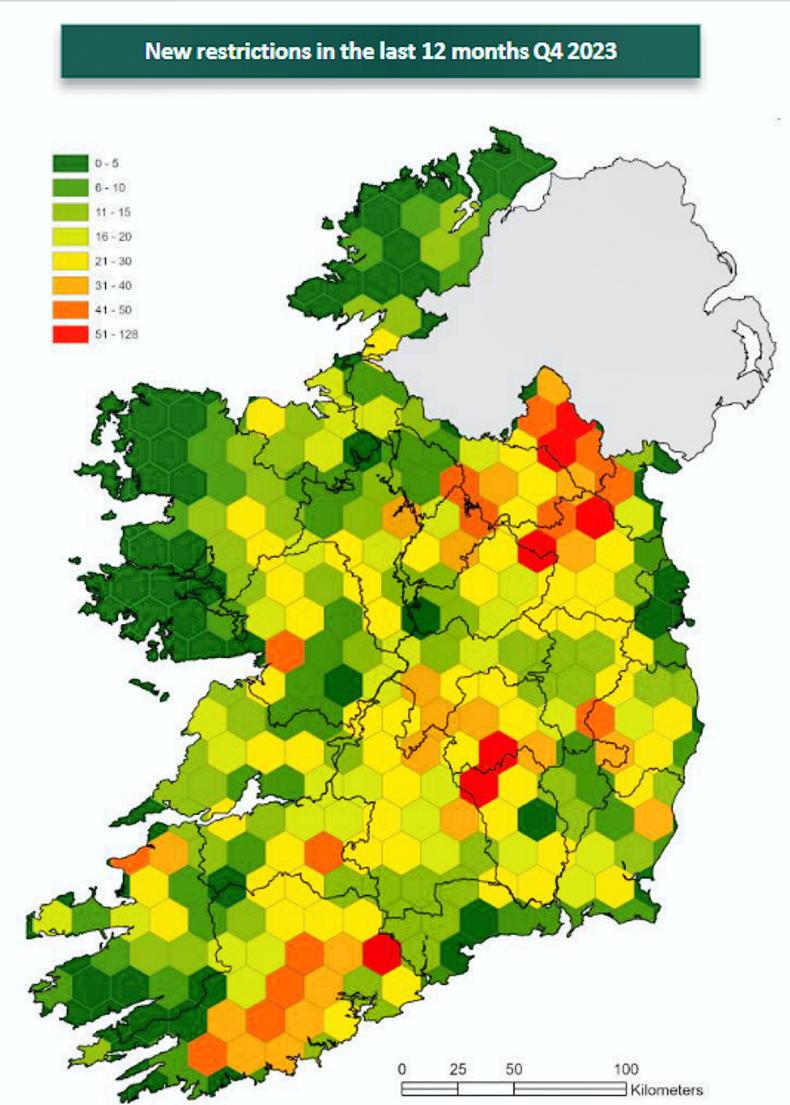TB reactors increased by 5,500 to reach a total of 28,868 head in 2023, with all of the disease’s main metrics worsening in year-end figures reported by the Department of Agriculture.
The total figure represents a 24% reactor rise over 12 months and an increase of 38% in two years.
There were 5,078 herds hit with restrictions during 2023 – a 13% increase on 2022.
The rolling yearly herd incidence jumped to 4.89% by the end of last December, according to the Department’s provisional figures.
After starting at 4.27% in January, this was the highest herd incidence witnessed in recent years.
These are all herds which experienced a new breakdown over the year. Last year’s herd incidence figure is around one third higher than the 3.72% figure reported in 2019.

The distribution of herds hit with new TB restrictions in 2023. \ Department of Agriculture
These reactor and herd incidence figures are the highest they have been in over a decade and the cost of running the Department of Agriculture’s TB eradication programme is more expensive than ever.
The total cost of the programme amounted to €74.2m in 2023 – a 29% jump on the programme’s bill in 2022.
This represents more funding than goes annually to the Suckler Carbon Efficiency Programme or the Organic Farming Scheme.
Last year, the cost of cattle valuations rose by €12m to €34.7m, farmer compensation increased by almost 40% to €5m and wildlife costs hit €7.7m.
To cater for the worsening disease trends, a €22m funding top-up had to be allocated to the TB eradication programme in 2023 due to what Minister for Agriculture Charlie McConalogue recently described as a “disappointing and worrying increase in TB reactors”.
Northern Ireland
In Northern Ireland, the number of cattle removed off farms as reactors hit a new record yearly high of 18,149 head in 2023, the latest figures published by the Department of Agriculture, Environment and Rural Affairs (DAERA) show.
The numbers are up 5% on the 2022 total and around 40% ahead of what was seen in 2019 and 2020.
Across last year there were 2,199 new herds which had a breakdown and 3,107 herds had at least one reactor at a TB test.
Herd incidence (the number of new reactor herds out of the total that tested) at the end of 2023 stood at 10.05%.
Read more
TB reactor numbers up over 10% as herd incidence falls
'Substantial increase' in TB reactor numbers since 2022
TB reactors now 70% higher than 10 years ago
TB reactors increased by 5,500 to reach a total of 28,868 head in 2023, with all of the disease’s main metrics worsening in year-end figures reported by the Department of Agriculture.
The total figure represents a 24% reactor rise over 12 months and an increase of 38% in two years.
There were 5,078 herds hit with restrictions during 2023 – a 13% increase on 2022.
The rolling yearly herd incidence jumped to 4.89% by the end of last December, according to the Department’s provisional figures.
After starting at 4.27% in January, this was the highest herd incidence witnessed in recent years.
These are all herds which experienced a new breakdown over the year. Last year’s herd incidence figure is around one third higher than the 3.72% figure reported in 2019.

The distribution of herds hit with new TB restrictions in 2023. \ Department of Agriculture
These reactor and herd incidence figures are the highest they have been in over a decade and the cost of running the Department of Agriculture’s TB eradication programme is more expensive than ever.
The total cost of the programme amounted to €74.2m in 2023 – a 29% jump on the programme’s bill in 2022.
This represents more funding than goes annually to the Suckler Carbon Efficiency Programme or the Organic Farming Scheme.
Last year, the cost of cattle valuations rose by €12m to €34.7m, farmer compensation increased by almost 40% to €5m and wildlife costs hit €7.7m.
To cater for the worsening disease trends, a €22m funding top-up had to be allocated to the TB eradication programme in 2023 due to what Minister for Agriculture Charlie McConalogue recently described as a “disappointing and worrying increase in TB reactors”.
Northern Ireland
In Northern Ireland, the number of cattle removed off farms as reactors hit a new record yearly high of 18,149 head in 2023, the latest figures published by the Department of Agriculture, Environment and Rural Affairs (DAERA) show.
The numbers are up 5% on the 2022 total and around 40% ahead of what was seen in 2019 and 2020.
Across last year there were 2,199 new herds which had a breakdown and 3,107 herds had at least one reactor at a TB test.
Herd incidence (the number of new reactor herds out of the total that tested) at the end of 2023 stood at 10.05%.
Read more
TB reactor numbers up over 10% as herd incidence falls
'Substantial increase' in TB reactor numbers since 2022
TB reactors now 70% higher than 10 years ago







 This is a subscriber-only article
This is a subscriber-only article










SHARING OPTIONS: